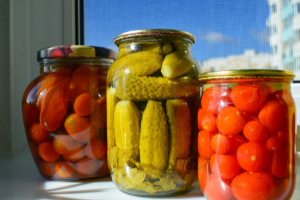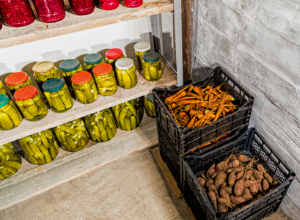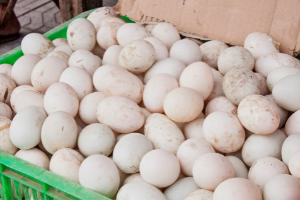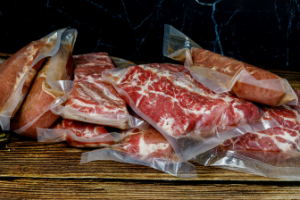Editor’s note: This article first appeared on Self-Sufficient Projects.
Can you imagine living without a fridge?
Humans have lived like that for millennials. The difference is that they had a few tricks up their sleeves that helped them survive.
Even today, people still live without refrigeration – some because of unfortunate circumstances, and others want to lower energy costs or cut dependence on the grid.
Whatever the reason, here’s how you can live without refrigeration.
Seasonal Eating
A first step on the journey to living without refrigeration is eating local, seasonal food.
It doesn’t matter whether you’re buying it from the market or growing it yourself. The more local and seasonal, the better.
• During spring, there’s usually a surplus of eggs, which is great because many foods will be gone or petering out. This is also a great time to enjoy maize, barley, rice, and other spring crops.
 • During summer, vegetables and fresh greens abound, allowing you to eat an almost meat-free diet.
• During summer, vegetables and fresh greens abound, allowing you to eat an almost meat-free diet.
There are also many wild edibles to pick and choose from in summer.
You can find and identify them effortlessly and safely in most forests.
⇒ The Ultimate Survival Food You Can Only Harvest This Summer
• During fall, excess animals are slaughtered, which provides the protein you and your family need to get through the cold winter months.
• Winter is the best season for storing any food as you can harness the cold temperatures to keep your food fresh.
Of course, this varies from location to location, but each area has a different natural rhythm of seasonal foods.
Food Preservation
After adopting a seasonal diet, you need to learn the traditional tricks your forefathers used to preserve their bounty.
• Drying is a preservation method that uses the wind and sun to reduce water activity in your food.
• Freezing without a fridge involves freezing water in the cold snow and placing it in a cooler along with your foodstuffs.
• Smoking flavors, cooks, and preserves food by exposing it to smoke from burning wood.
• Salting/Curing removes moisture from foods like meat.
 • Pickling involves preserving food in brine or marinating it in vinegar.
• Pickling involves preserving food in brine or marinating it in vinegar.
• Sugar in syrup or crystallized form can preserve fruits.
• Bottling and canning involve sealing cooked food in sterilized cans and bottles.
⇒ Click Here To Learn How To Can Hamburger Meat For Long Term Preservation
• Lye prevents bacterial growth by turning food alkaline.
• Jellying is a preservation method whereby you cook food in a substance that solidifies to form a gel.
• Potting involves placing meat in a pot and sealing it with fat.
• Jugging involves preserving meat by stewing it in wine, brine, or animal blood.
• Burial in the ground involves burying your food underground where there is no oxygen or light.
Build A Root Cellar
 A root cellar is any storage that uses humidifying, insulating, and natural cooling properties of the earth.
A root cellar is any storage that uses humidifying, insulating, and natural cooling properties of the earth.
It is your best option for storing root vegetables like potatoes, carrots, beets, turnips, rutabagas, and parsnips. You can also use it to store rhizomes or bulbs of perennial flowers and pickled or canned vegetables.
A secondary use for a root cellar is storing beer, wine, and other alcoholic beverages.
There are a few types of root cellars you can build:
⇒ How To Build The Invisible Root Cellar
• Basement Root Cellar: This type of root cellar is attached to the house for easy access.
• Hole-in-the-Ground Cellar: This option requires you to dig horizontally into a hillside or down in the ground.
• Garbage Can: This root cellar is probably the easiest to make as all you need to construct it is to dig a hole and place a metal barrel or garbage can inside. You then add some straw at the bottom of the can, then your food stuffs.
Don’t Over Cook
Another great solution to living without a fridge is not having leftovers.
If you can start scaling back on your food portions, then you won’t have to worry about leftovers and the need to refrigerate anything.
Use Food That Doesn’t Spoil Quickly
Not every food goes bad quickly. In fact, most of the healthiest foods will keep surprisingly well without special storage.
• Homemade bread doesn’t go moldy like store-bought bread. Instead, it dries out, and you can use it for making all sorts of tasty foods like French toast.
• Raw milk sours but doesn’t spoil, which is terrific for making pancakes, biscuits, and more.
• Unwashed farm fresh eggs last surprisingly long in a cool, dry pantry.
Unwashed farm fresh eggs last surprisingly long in a cool, dry pantry.
To be frank, I have been able to store commercial eggs for a relatively long time in the pantry too.
Related: How to Keep Eggs Fresh for a Year with Isinglass
• Butter can last for a long time on the counter. But during summer, we rarely buy it, as it can’t cope with high temperatures.
• Raw honey can last for decades, if not longer! Did you know that it’s also great for dressing wounds?
• Mustard lasts longer than mayonnaise.
Food Types And Their Refrigeration Needs
Vegetables
Vegetables can last up to 3 months without refrigeration, but make sure you buy ones that have never been refrigerated.
Additionally, ensure you choose produce that’s not overripe, bruised, rotten, or looks old, and don’t wash the produce before storing it.
Here’s the length of time to store your vegetables:
[wptb id=56981]
Bear in mind that herbs, broccoli, lettuce, cauliflower, or any vegetable with a stem will store superbly well if you submerge its ends in water.
Fruits
Refrigeration cuts the shelf-life of fruits by 50%. However, getting unrefrigerated fruits from the local store is difficult. You’ll have to buy it directly from farmers or farmers’ markets.
Most fruits don’t need refrigeration, but some have a shorter shelf-life than others. Here’s the average shelf-life of fruits without refrigeration:
[wptb id=56983]
Dairy
Dairy products have different shelf lives:
• Butter: Has a shelf-life of at least 2 weeks and as many as 4 weeks if it’s in a cool, dry place. However, you can make clarified butter yourself. It doesn’t need to be refrigerated, and can be stored for up to one whole year and even beyond.
• Yogurt: Small-size yogurts can last for a few weeks, provided they’re unopened. If you bought the larger size, eat it within two days.
• Cheese: Hard cheese, vacuum-sealed or coated in wax can last for years without refrigeration.
• Milk: You cannot get milk to last more than 6 hours without refrigeration. The best solution is to get yourself a milking goat or cow, buy fresh milk daily, or use powdered milk.
Meat
 Fresh meat is difficult but not impossible to store without refrigeration, here are your best options:
Fresh meat is difficult but not impossible to store without refrigeration, here are your best options:
• If you buy vacuum-sealed and frozen meat from the butcher, store it in a cooler or freezer bag for up to a week.
• You can also preserve the meat by curing and smoking it.
Eggs
Unwashed eggs can last for a month at room temperature. If you want your eggs to last even longer, you can waterglass them. Eggs that are preserved with the water glassing method can last up to a year or more.
If you can keep egg-laying chickens – the better!
Grains & Starches
Uncooked grains and starches don’t require refrigeration.
Condiments
Most condiments will keep just fine for months without refrigeration. That includes catsup, mayonnaise, peanut butter, mustard, and relish.
Other spreads like maple syrup, jams, molasses, and jellies will keep for 1-3 months. Honey can last for decades without going bad. If it crystallizes, gently reheat it.
Living without refrigeration can be frustrating at times, but it sure is a worthwhile undertaking you should try.






















Nice!!
you do look nice today Chuck
My family had a large garden on my grandfather’s farm in Michigan. We canned and froze (as freezers became reasonable.)
We had wood barrels in the basement for apples and potatoes. When they were ready we wrapped each in newspaper and placed in the appropriate barrel. As the winter progressed, the quality declined, but usage changed- fewer boiled and baked potatoes, more fried and mashed. Left over potatoes were planted in the spring.
Waterbathing eggs is a good idea… Just don’t over fill the bucket and leave room for “compression “
Great great information
People need to study this information instead of fighting with each other
My dad told me they kept milk in the well, lowered down in a wire basket.
In Tennessee that is, before they moved to Beverly ……
My grandparents had a well room built behind a store they ran. It was always cooler than outside or in their house. In a bucket in the well they kept milk and butter. It was always very cold. This was in Anacoca, Louisiana, near Leesville.
Texas tea? LOL
My grandfather knew a guy who kept his milk chilled by the output from an artesian well, had a little building around it. Very convenient.
Back before refrigeration, my ancestors used to eat their larger meal at noon and cooked enough that the evening meal was food leftover from the noon meal.
Of course, scraps were fed to the animals.
Chickens (and other small animals) were not butchered until shortly before they were eaten.
Thank you
This is a fantastic summary
Obrigado por este email, me ajudou muito aqui no Brasil. Agradeço muito.
“muitas beijocas” to you too asi me dicia una linda criatura de portugal hablo español adoro lo romantico del portuges.
“lots of kisses” to you too that’s what a lovely creature from portugal would say to me, y speak spanish and adore how romantic portuguese sounds
As a kid, we lived without refrigeration while my father was building a summer house. Heck, we lived without electricity. It wasn’t a challenge as my parents and grandparents knew exactly what to do. It anything, us kids were disappointed when we finally did get electricity and all the things that go with it. No more popping corn in the fireplace or playing cards every night by candle light except if we happened to lose power in a storm. It was a good lesson to learn as now it really is no big deal should power be interrupted, instead it’s an opportunity to simply enjoy doing things the old fashion way. This is an excellent article and in my opinion a real keeper. Good to save to show those who so far haven’t had such an opportunity! Life is all how you look at it!
I always loved power outages as a kid! For some reason it was the only time my family really spent quality face to face time.
?
The man who built Coral Castle down in Florida had some interesting refrigeration. I took a tour of that place about ten years ago. If anyone is ever in the area, it’s worth a look. There’s also a documentary or two out there.
Hi Big T. Ed Leedskalnin was a Secretive Genius that just may have Known the Technique of Manipulating those Huge Stones.
Working Solo and Only at Night he was Once Spotted by a Young Boy who said he was holding Things Akin to Ice Cream Cones as he Worked…
I Have his Books and Patents which Were Available Freely with Some Delving,.
Before the Bit Burning and Globalist Parasitic NWO Kull Started in Full Lockstep.
I Lived in Homestead for a few months in the 70’s and was Unaware of the Coral Castle at the Time.
Wish I’d have Known and Visited.
A Mini Egypt.
Gotta Love Sacred Geometry! ??
I don’t doubt there’s some as-yet undiscovered (or long-forgotten) knowledge which allows for moving massive stones. But the stones Leedskalnin moved were not impossible. His secrets were mostly excellent techniques, and some Dade County Pine. The man really knew his stuff. I’m not saying what he did was easy. If you ever get the chance to go, the guides will show you what I mean. Many of his tools are still on site. Mr. L is exactly the kind of gentle madman you’d want post-shtf. He’d be the guy to help you move your house from one side of the lot to the other, without a crane.
That being said, HOLD ON to those books. If it’s being burned, banned, or confiscated, it is likely precious in some way.
Some of this advice is pretty wacky. Maybe things are different regionally, but I don’t know where maize is a spring crop? Maybe the equator? Even my March planted barley isn’t ready until July. If you need fresh, high calorie, veggies in the spring, root crops are your best bet – over wintered carrots and potatoes in places that are warm enough, parsnips, sunchokes, salsify, cattail roots, turnips, beets, small radishes. (The larger radishes won’t be ready until later)
The shelf life of many of those veggies is way off too. Properly stored, the shelf life of sweet potatoes, and many varieties of squash and pumpkin are more like 1-2 years, not months. And potatoes and onions properly stored is more like 3-12 months depending on the variety. I know i left my kennebec and pontiac potatos sitting in a box on my counter for about 6 months and had no rotting and they only started sprouting in the last month.
Critisicm aside, great advice about putting stemmed veggies in water. My family always thought i was weird when they came over and saw vaces of lettuce, cilantro celery, etc. But it really works. And if your vace lettuce bolts you can save the seeds!
I have never heard of jugging before thanks for a new tangent for me to look into!
Burying a garbage can in the ground doesn’t work in the northern climates. Tried it 30 years ago, put straw in filled it with food items, more straw on top. Just too cold up here, northern SD, everything was frozen solid. Probably works in warmer areas.
you out did yourself, my hat off, thank you
If I buy this do I actually get physical books sent to me? I prefer books over e-mail access.